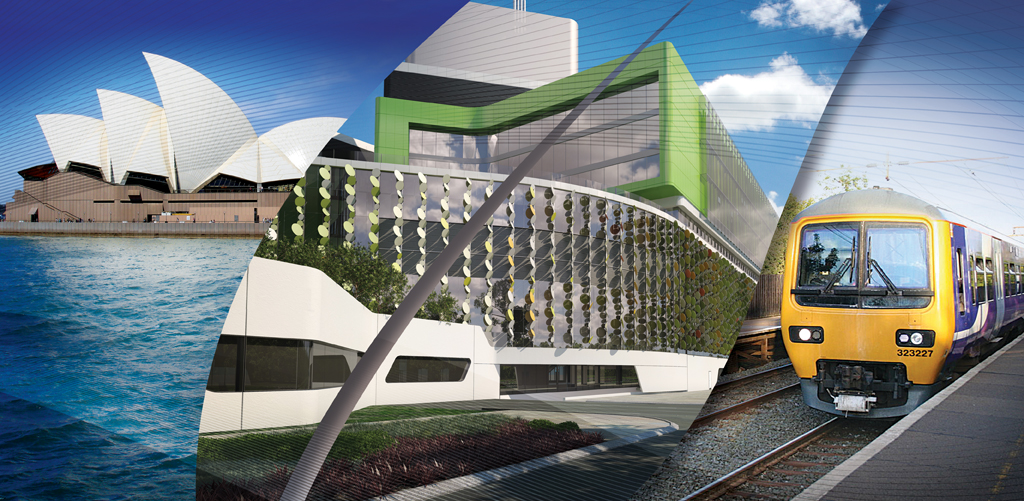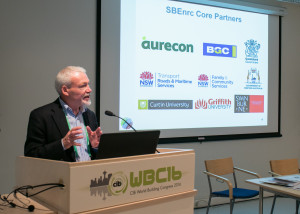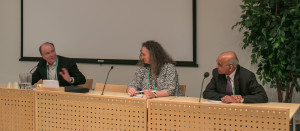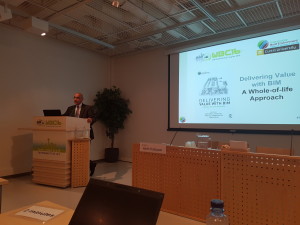In 2013, the Australian Department of Industry identified lifting productivity and economic growth as one of the most important challenges that Australia is facing. In 2014, the Australian Productivity Commission highlighted that a more widespread adoption of Building Information Modelling (BIM) could enhance productivity across the industry and in turn have a positive impact on the cost structure of infrastructure projects.
Findings from SBEnrc Project 2.24 Integrated Project Environments (2013-14) pointed to the need for: (i) more effective procurement models that allow the use of BIM as a tool for whole-of-life asset management; and (ii) the integration of measurable indicators that can be used from the early procurement phases and carried through the entire life-cycle of constructed assets.
This project (2014-15) aimed to identify and assess this added value of creating industry benchmarks for implementing BIM in whole-of-life asset management, with a focus on procurement methods and efficiency gains for infrastructure and building. Outputs from this project will provide a base for clients to improve their approach to implementing BIM and monitoring their progress towards fully integrated whole-of-life asset management systems.
Industry Report (5 November 2015 – 4.2MB)
Project Objectives
- Define indicators to measure tangible and intangible benefits of BIM across a project’s life-cycle in infrastructure and buildings.
- Pilot test a whole-of-life BIM value realisation framework on leading infrastructure and building case studies and validate the NATSPEC National BIM Guide within this context.
Industry Outcomes
This project delivered:
- BIM Value Realisation Framework and BIM Value, an interactive online tool to develop a benefit realisation and monitoring strategy, in line with NATSPEC National BIM Guide.
- Three Australian exemplar case studies across design, construction and asset management showcasing benefits, tools and metrics for uptake of BIM.
- Advanced knowledge base of benefits from transitioning from 2D asset management and delivery systems to 3D integrated digital built environments.
Although there are numerous studies and articles on the benefits of BIM, it can be difficult for organisations to assess its potential value for their particular purposes. Even when they have decided to use BIM, it is often not clear how to best implement it.
The BIM Value tool has been developed by the Sustainable Built Environment National Research Centre (SBEnrc) in partnership with NATSPEC to address these issues. It is based on a comprehensive methodology developed as part of SBEnrc’s research based on academic and industry research. The content was developed in close consultation with industry, government and research organisations across Australia and internationally. This ensures that it is relevant to a range of stakeholders. The information used to develop the tool is detailed in the book Delivering Value with BIM – A Whole-of-life Approach by Adriana Sanchez, Keith Hampson and Simon Vaux to be published by Routledge in March 2016. Work to improve the tool will continue over 2015 – 2017.
BIM Value is a free open-access tool that provides managers with a step-by-step guide to identifying potential benefits, metrics and tools for implementing BIM.
Case Studies
This project leveraged off national exemplar projects through case studies to develop and test the value realisation framework:
Design – New Generation Rollingstock Depot, Queensland
This purpose-built train maintenance depot is being delivered at Wulkuraka in Ipswich as part of a AUD$4.4b public-private-partnership. It is part of the Queensland Government’s New Generation Rollingstock project which will ultimately provide 75 new six-car trains, maintenance of these trains for a period of around 30 years, and construction and maintenance of a train maintenance depot. The Queensland Department of Transport and Main Roads awarded the contract to a consortium comprising Bombardier Transportation, John Laing, ITOCHU Corporation and Uberior. Laing O’Rourke is the Design and Construct contractor for the train maintenance depot.
For more information about the New Generation Rollingstock project please go to: https://www.tmr.qld.gov.au/ngr
Case Study Report (25 September 2015 – 2.1MB)
Construction – Perth Children’s Hospital, Western Australia
This AUD1.2 billion project will replace Princess Margaret Hospital as Western Australia’s dedicated children’s hospital to provide the best possible clinical care for future generations and as a location for outstanding paediatric research. The hospital project team has endeavored to carry out extensive consultation and research to benchmark their work against national and international best practice design and service models. The project is currently being carried out under a Stage One Managing Contract awarded to John Holland Pty Ltd. This project is under construction and due for practical completion in July 2015.
For more information about the Perth Children’s Hospital please go to: https://www.newchildrenshospitalproject.health.wa.gov.au/Home.aspx
Case Study Report (11 August 2015 – 3.9MB)
Asset Management – Sydney Opera House, New South Wales
The Sydney Opera House is a global icon and probably one of 20th century’s greatest buildings receiving over eight million visitors every year. The House is currently the subject of major construction work including a new set of tunnels for servicing and car parking and a sub-level loading dock. In 2007, the CRC for Construction Innovation, the predecessor to SBEnrc, published Adopting BIM for Facility Management: Solutions for Managing the Sydney Opera House which investigated the opportunity for implementation of BIM to support enhanced asset management. This project started the journey of the Sydney Opera House towards more advanced use of BIM for asset management which is still ongoing. This case study will revisit this exemplar project and review the value of BIM in practice.
For more information about the Sydney Opera House please go to: https://www.sydneyoperahouse.com/about_us.aspx
Case Study Report (12 October 2015 – 6MB)
Documents for Downloading and Other Publications
The following documents provide additional detail regarding this current research, including project outcomes to date:
SBEnrc Project 2.34 Factsheet (04 December 2014)
Book: Sanchez AX; Hampson KD and London G (eds), “Integrating Information in Built Environments”, Routledge, Abingdon, UK, July 2017
Chapters:
Sanchez AX, Brooks J and Hampson KD, “Information Integration and Public Procurement – The role of Monitoring, Benchmarking and Client Leadership”, in Sanchez AX, Hampson KD and London G (eds), “Integrating Information in Built Environments”, Routledge, Abingdon, UK, July 2017.
Sanchez AX, Hampson KD and London G, “Integrating Information across Built Environment Boundaries”, in Sanchez AX, Hampson KD and London G (eds), “Integrating Information in Built Environments”, Routledge, Abingdon, UK, July 2017.
Sanchez AX, London G and Hampson KD, “Contrasting aspects of information integration” in Sanchez AX, Hampson KD and London G (eds), “Integrating Information in Built Environments”, Routledge, Abingdon, UK, July 2017.
Sanchez AX, Hampson KD and Mohamed S (2015) Measuring Benefits from BIM across Whole-of-life Asset Management, presented at the International Road Federation/Roads Australia Regional Conference Asia and Australasia, 04 May, Sydney, Australia.
Sanchez AX, Hampson KD and Mohamed S (2015) Perth Children’s Hospital – Case Study Report, Perth: Sustainable Built Environment National Research Centre.
Utiome E, Mohamed S, Sanchez AX and Hampson KD (2015) New Generation Rollingstock Depot – Case Study Report, Perth: Sustainable Built Environment National Research Centre.
Sanchez AX, Hampson KD and Mohamed S (2015) Sydney Opera House – Case Study Report, Perth: Sustainable Built Environment National Research Centre.
Sanchez AX, Hampson KD and Mohamed S (2015) Driving Whole-of-life Efficiencies through BIM and Procuremen Industry Report, Perth: Sustainable Built Environment National Research Centre.
Sanchez AX and Hampson KD (2015) Delivering Value with BIM, The Earthmovers and Civil Contractor, August issue, p.16
Sanchez AX, Hampson KD and Mohamed S (2016) Delivering Value with BIM: A Framework for Built Environment Practitioners, paper to be presented at CIB World Building Congress 2016, Tampere, Finland, 30 May – 3 June.
Sanchez AX, Hampson KD and Vaux S (2016) Delivering Value with BIM: A Whole-of-life Approach, London: Routledge (Available for purchase, 20% Discount Code: DC361) Chapter Abstracts).
Delivering Value with BIM presentation at BIM4Clients Breakfast co-hosted by BIM Academy & Point Advisory in Melbourne (12 August 2016)
Expert discussion session on the topic of information integration with four academic and industry experts Kalle Kähkönen from Finland, Chrisna Du Plessis from South Africa and Shyam Sunder the US at the CIB World Building Congress 2016 in Tampere, Finland (01 June 2016)
Delivering Value with BIM (outcome of Project 2.34) launched and endorsed by an adviser to the US Government Dr Shyam Sunder at CIB World Building Congress, Tampere, Finland (01 June 2016)
CIB Task Group 90: Information Integration in Construction (IICON)
SBEnrc is leveraging on the international collaboration network formed in the SBEnrc Project 2.7 Leveraging R&D Investment for the Australian Built Environment through the International Council for Research and Innovation in Building and Construction (CIB) Task Group 85 R&D Investment and Impact, to form a new Task Group 90 focused on Information Integration in Construction (IICON). This group will compliment activities of SBEnrc Project 2.34 Driving Whole-of-life Efficiencies through BIM and Procurement and continue the research efforts started in Project 2.24 Integrated Project Environments to add more value to our Centre Partners.
IICON activities will focus on creating a more effective and reflective industry and deliver benefits to public and private asset owners through:
- efficient knowledge creation, preservation and integration across the life-cycle of constructed facilities
- relevant, reliable, interoperable and long-lasting data and information gathering and analysis
- monitoring and feedback from end-users into the different stages of design, construction and asset management of buildings and infrastructure.
CIB TG90 – Notes of Meeting – 26 November 2014 (12.01.15 – 410 Kb)
CIB TG90 – Notes of Meeting – 18 February 2015 (04.03.15 – 427 Kb)
CIB TG90 – Notes of Meeting – 07-May-2015 (29.05.15 – 392 Kb)
Sanchez, Rempling and Jung presentation – 07 May 2015 (29.05.15 – 5.5 MB)
CIB TG90 – Notes of Meeting – 18 February 2016 (24.03.16 – 340 Kb)










